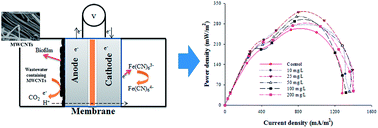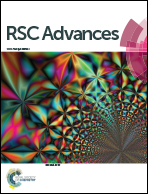Effect of wastewater containing multi-walled carbon nanotubes on dual-chamber microbial fuel cell performance
Abstract
The use of engineered nanomaterials is continuously increasing in commercial products and industrial applications, and a significant portion of these materials may enter domestic and industrial wastewater streams and subsequently, wastewater treatment plants. Microbial fuel cells (MFCs) represent a new emerging technology for simultaneously generating bioenergy and treating wastewater. In this work, the performance of a MFC with wastewater containing multi-walled carbon nanotubes (MWCNTs) was evaluated. No significant negative effect on power generation was observed for MWCNT concentrations from 10 mg L−1 to 200 mg L−1. In fact, there was a stimulating effect due to the increased conductivity resulting from the MWCNTs, therefore slightly enhancing voltage generation (linked to enhanced electron transfer rate). The maximum voltage generation was increased from 0.61 V to 0.68 V (at 1000 Ω external resistance). Low lactate dehydrogenase release at all concentrations of MWCNTs showed that no adverse cell piercing took place and the wrapping of cells by MWCNTs most likely occurred. Chemical oxygen demand (COD) removal efficiency was also enhanced from 74.2% to 84.7%. The experimental results demonstrated that wastewater containing MWCNTs can be applied to MFCs for generating bioelectricity and treating wastewater without any significant adverse effect on performance.


 Please wait while we load your content...
Please wait while we load your content...